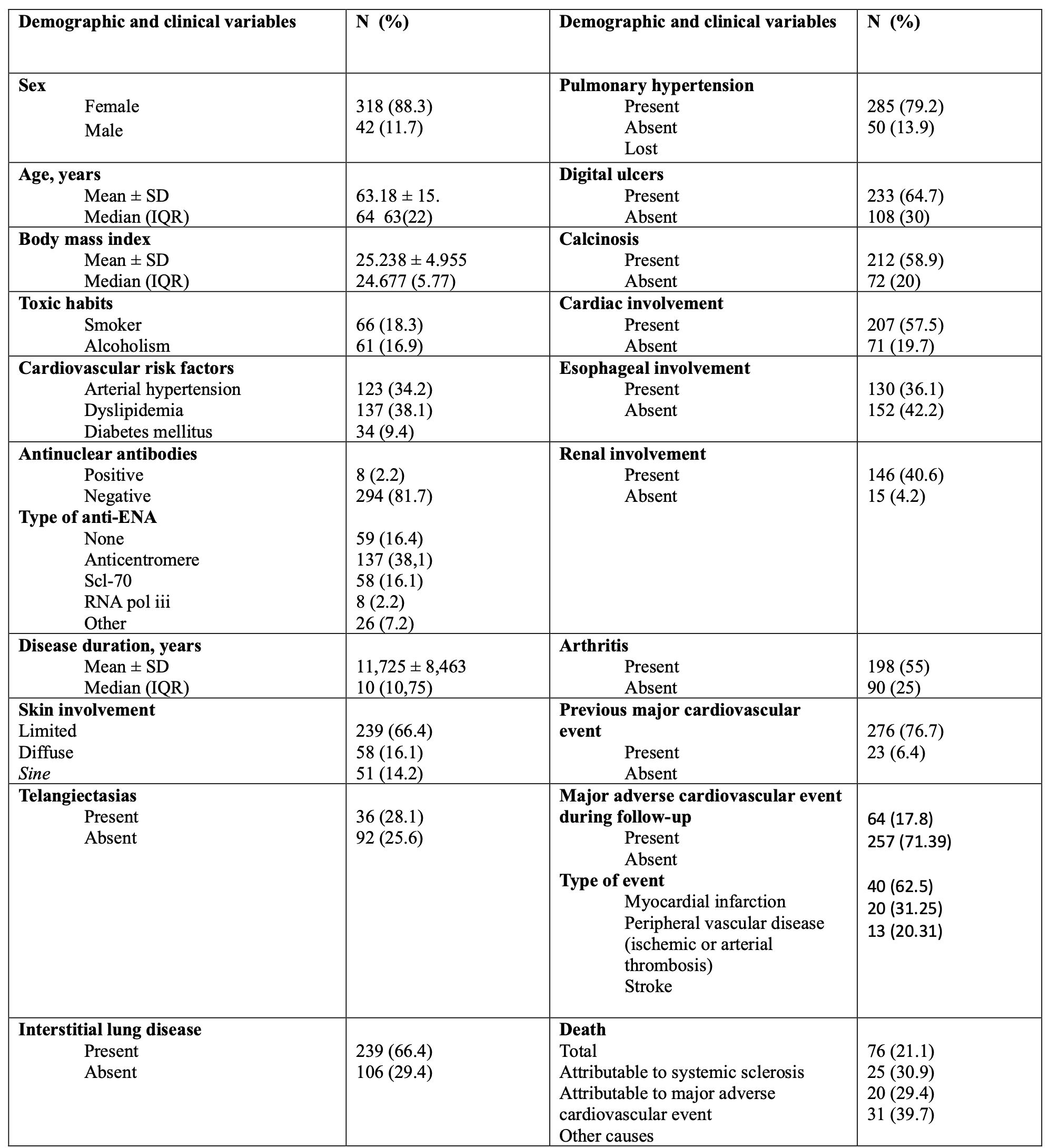Session Information
Session Type: Poster Session C
Session Time: 10:30AM-12:30PM
Background/Purpose: Systemic sclerosis (SSc) is a disease with high morbidity and mortality. Nailfold capillaroscopy (NFC) is a widely used method for its diagnosis. Our objective was to analyze the association between NFC at the time of diagnosis and major adverse cardiovascular events (MACEs) and mortality, during follow-up.
Methods: Multicenter retrospective observational study which included all patients from a longitudinal SSc cohort, classified according to the EULAR/ACR 2013 criteria, followed between 1984 and 2023. The demographic, clinical and laboratory data were recorded.
The qualitative analysis of the findings in the NFC at the time of the diagnosis included the presence of megacapillaries, hemorrhages and avascular areas, as well as Cutolo’s SSc NFC patterns. MACEs and deaths, as well as their respective causes, were obtained from the patient’s medical history.
An univariate analysis was carried out and a multivariate logistic regression model was built, examining the effect of the findings in the NFC on the clinical events. To study the survival of patients, Kaplan-Meier curves and Cox-regression models, were designed. The statistical analysis was performed using SPSS v.26.
Results: 360 patients were included. The baseline characteristics are described in table 1.
In the NFC at baseline, 88% presented with scleroderma patterns of microvascular damage (29.7% early, 29.2% active and 22.5% late). 69.7% exhibited megacapillaries, 48.6% hemorrhages and 38.6% avascular areas.
In the univariate model, there was a positive association between age (p = 0.000), arterial hypertension [AH] (p = 0.001), dyslipidemia (p = 0.0022), diabetes mellitus (p = 0.0035), interstitial lung disease [ILD] (p = 0.001), pulmonary hypertension [PH] (p = 0.000), digital ulcers [DUs] (p = 0.000), renal involvement (p = 0.009), cardiac involvement [CI] (p = 0.000), calcinosis (p = 0.009), previous MACE (p = 0.000), and avascular areas (p = 0.000) with MACEs. Hemorrhages had a negative association (p = 0.013).
There was a positive association between age (p = 0.000, p = 0.001), disease duration (p = 0.000, p = 0.005), AH (p = 0.000, p = 0.016), ILD (p = 0.000, p = 0.000), CI (p = 0.000, p = 0.000), DUs (p = 0.002, p = 0.045), previous MACE (0.002, p = 0.027) and avascular areas (p = 0.000) with all-cause mortality and mortality by SSc, respectively. Moreover, both outcomes had a negative association with hemorrhages (p = 0.023, p = 0.018).
For mortality by MACE, age (p = 0.000), AH (p = 0.006), PH (p = 0.000), DUs (p = 0.006), CI (p = 0.000), previous MACE (p = 0.027) and avascular areas (p = 0.000) were associated.
The results of the logistic regression models, for MACEs, all-cause mortality, mortality due to SSc and mortality due to MACE, are presented in table 2.
The Kaplan-Meier curve showing the effect of avascular areas on survival rates is presented in figure 1 (log rank p-value = 0.000). The Hazard ratio (HR) for hemorrhages and all-cause mortality was 0.421 (p = 0.006) and 0.315 (p = 0.043) for death by SSc.
Conclusion: Presence of avascular areas in NFC at baseline are an independent risk factor for all-cause mortality and specifically due to SSc. Hemorrhages seem to have a protective effect on SSc survival rate, acting as a sign of the early stages of the microvascular damage.
To cite this abstract in AMA style:
Valera-Ribera C, Narvaez-García J, Lacasa-Molina J, Perea-Galera L, Taberner-Cortés A, Mencio-Viana P, Leon-Torralba P, Mayo-Juanatey A, Andújar-Brazal P, Vázquez Gómez I, Ybáñez-García D, Martínez-Ferrer À, Valls-Pascual E, Robustillo Villarino M, ALEGRE SANCHO J. Use of Nailfold Capillaroscopy as a Predictor of Cardiovascular Events and Mortality in Systemic Sclerosis [abstract]. Arthritis Rheumatol. 2024; 76 (suppl 9). https://acrabstracts.org/abstract/use-of-nailfold-capillaroscopy-as-a-predictor-of-cardiovascular-events-and-mortality-in-systemic-sclerosis/. Accessed .« Back to ACR Convergence 2024
ACR Meeting Abstracts - https://acrabstracts.org/abstract/use-of-nailfold-capillaroscopy-as-a-predictor-of-cardiovascular-events-and-mortality-in-systemic-sclerosis/



